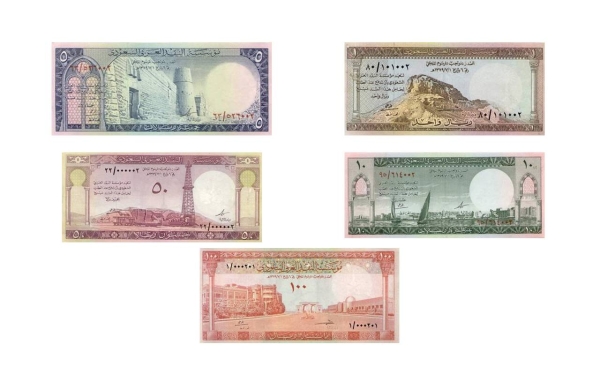
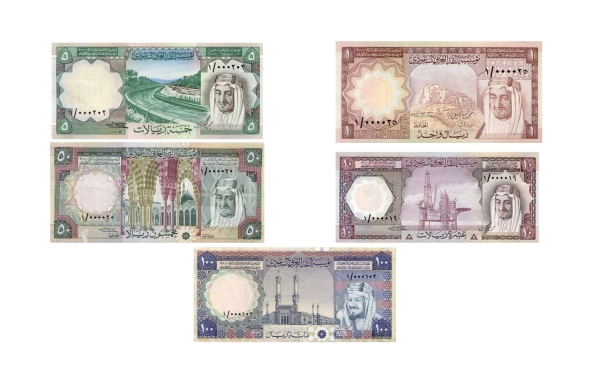
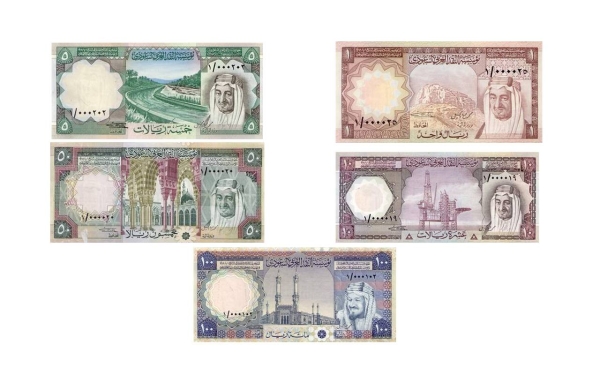
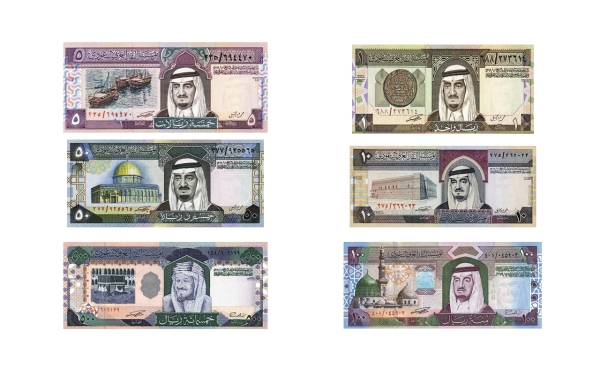
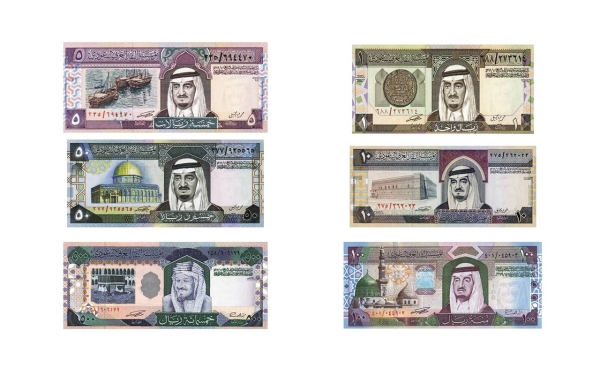
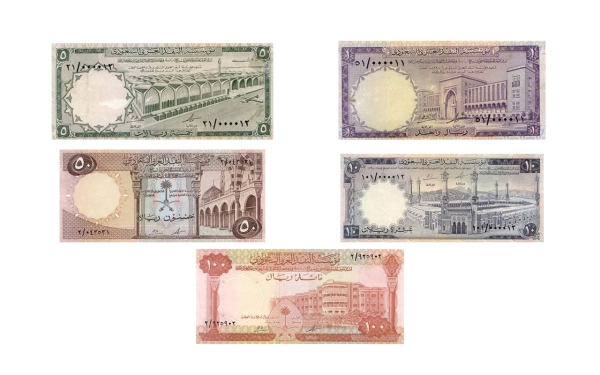
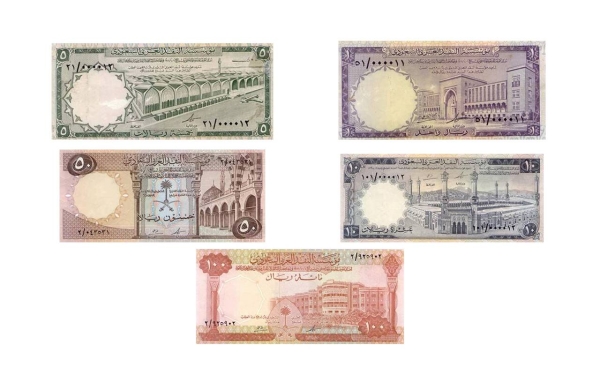
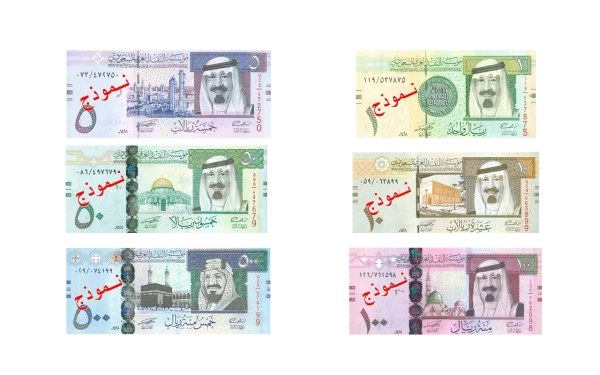
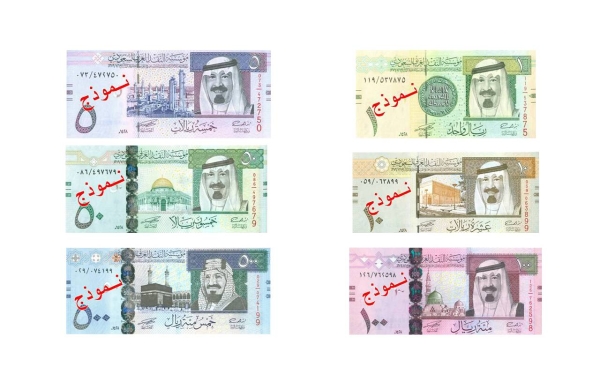
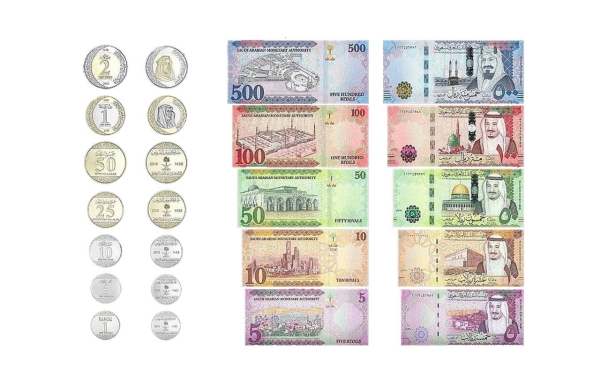
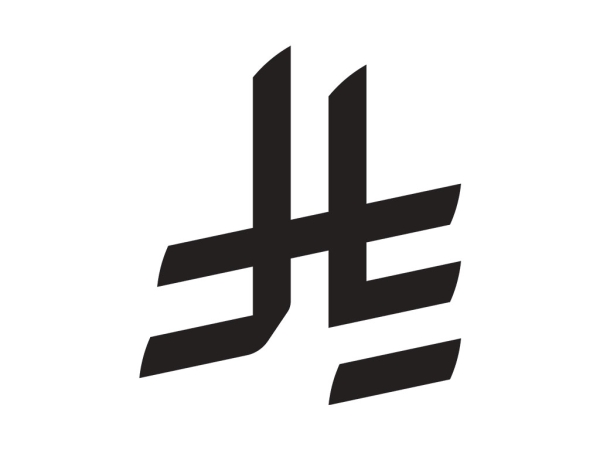
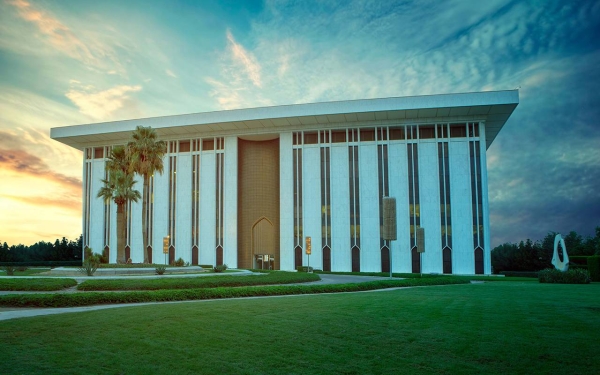
The Saudi Currency is the official currency of the Kingdom of Saudi Arabia. It is known as the 'Saudi Riyal' and abbreviated as 'SAR'.
On February 20, 2025, the Custodian of the Two Holy Mosques, King Salman Bin Abdulaziz Al Saud, approved the official symbol of the Saudi Riyal. Inspired by Arabic calligraphy, the symbol is now used in all financial and commercial transactions at the local, regional, and international levels.
Saudi Arabia coined its first currency issue in 1925, and the first currency denominations were quarter and half Qirsh. In 1935, the first currency bearing the name 'Kingdom of Saudi Arabia' was issued.
During the reign of the Founding King Abdulaziz Bin Abdulrahman Al Saud, in 1952, the Saudi Arabian Monetary Agency (currently the Saudi Central Bank) was established. It is considered the second oldest central bank in the Arab world. It is the entity entrusted with regulating financial affairs. The following year, it issued what was known as 'Pilgrim Receipts,' which marked the inception of Saudi paper currency. Since its establishment to the present day, the agency has made six issuances of the Saudi currency.
Over the past decades, the Saudi currency has witnessed commemorative issuances that immortalize important occasions. These include the issuance of two coins to mark the hundredth anniversary of the establishment of Saudi Arabia, and a coin commemorating Saudi Arabia's presidency of the G20 summit. Each issuance has been accompanied by changes in the color of the denomination and the image it contains. Notably, the sixth issuance during the reign of the Custodian of the Two Holy Mosques, King Salman Bin Abdulaziz, featured the first polymer banknote.
History of Saudi currency
Before the recapture of Riyadh by the Founding King Abdulaziz Bin Abdulrahman Al Saud in 1902, Saudi Arabia existed in a disorganized state regarding monetary transactions. Saudis utilized various methods in their monetary dealings, including bartering, where goods were exchanged directly, alongside the use of diverse foreign currencies. These included the Austrian Taler, commonly referred to locally as the 'Maria Theresien Dollar' or 'Al-Riyal Al-Fransi' (the French Riyal). Additionally, a variety of gold, silver, and copper coins circulated, including those made of copper-nickel alloy, which were particularly prevalent. Among foreign currencies, the British Pound, known colloquially as 'Jineah George' (George's Guinea) or locally as 'Jineah Abu Khiyal' (Guinea of the Horseman) due to its depiction of an equestrian, was notable. Other currencies in circulation included the Rupee and its fractions, the Egyptian Qirsh, as well as currencies from neighboring countries and East Asia, particularly from East India (Indonesia).
King Abdulaziz Bin Abdulrahman Al Saud aimed to stabilize monetary conditions and reduce the diversity of foreign currencies in local circulation. Prior to 1922, he counter-stamped the word 'Najd' on some of the commonly used and widely circulated currencies. Key currencies affected included the French Riyal and the Indian Rupee, along with various copper coins and Qirsh in circulation at the time. The stamped currencies became the officially recognized currencies at the time.
After King Abdulaziz unified Hejaz with Najd in 1925, he approved the use of some foreign currencies and counter-stamped them with the word 'Hejaz'. One of the rarest of these stamped currencies was the British monetary unit known as the Bronze Penny.
Saudi Arabia previously outsourced the minting of its currency, sending it abroad and receiving irregular batches in return. This was a consequence of the absence of a centralized Saudi monetary authority. Consequently, the exchange value of the Saudi silver Riyal declined, deviating significantly from its market value as a metal on the global stage. Hence, King Abdulaziz saw the need for an agency to manage the government's income, which was growing thanks to oil exports, and to regulate the monetary conditions that had suffered turmoil during that period.
In early 1952, King Abdulaziz approved an American Financial Mission headed by Mr. Arthur N. Young, an Economic & Financial Advisor. The mission was to provide necessary advice on financial and economic matters and assist in the development of Saudi Arabia’s monetary system. Based on the data, the recommendations indicated the establishment of an institution that would oversee financial affairs. After consultation with King Saud Bin Abdulaziz Al Saud, who was the Crown Prince at the time, on April 20, 1952, two royal decrees were issued, leading to the establishment of the Saudi Arabian Monetary Agency (SAMA) and the adoption of the law that defines its duties.
On July 25, 1953, SAMA issued what was known as the Pilgrims’ Receipts, which marked the beginning of the Saudi paper currency. The value of a receipt was ten Riyals. Five million receipts were printed in Arabic, Persian, English, Urdu, Turkish, and Malayan languages. A receipt would keep for the holder the value of Silver Saudi Riyals. This step was widely accepted by pilgrims due to their light weight and ease of carrying. They also became circulated in the local market among merchants and citizens, prompting SAMA to reissue them, along with two new denominations: the SAR5 issue, which was issued the following year 1954, and SAR1, which was issued in 1956.
The Pilgrims’ Receipts contained the following text on the front: "SAMA has issued this receipt to aid the holder in performing the Hajj, enabling easy and swift access to Arab Riyals while staying in Saudi Arabia, without incurring any exchange fees." The left side bore the text: "We confirm that SAMA holds in its treasury in Jeddah a specified amount (as indicated by denomination), upon the request of the bearer of this receipt. This amount is fully redeemable and will be promptly paid upon presentation by the bearer at any of SAMA’s centers." At the bottom are the receipt number and date for the year 1952, along with the signatures of the Governor, Deputy, and Vice Chairman of the Board of Directors. The front also contained the value of the voucher, which was written on the back in several languages: Arabic, English, Urdu, Turkish, Malay, and Persian.
The front of the first issue of the SAR10 denomination featured the emblem of Saudi Arabia at its center, whereas the second issue features a depiction of two sailboats nestled in the harbor of Jeddah. The SAR5 denomination featured an image of a sailing vessel in the port of Jeddah, and the SAR1 note depicted the gate of King Saud's palace in Jeddah.
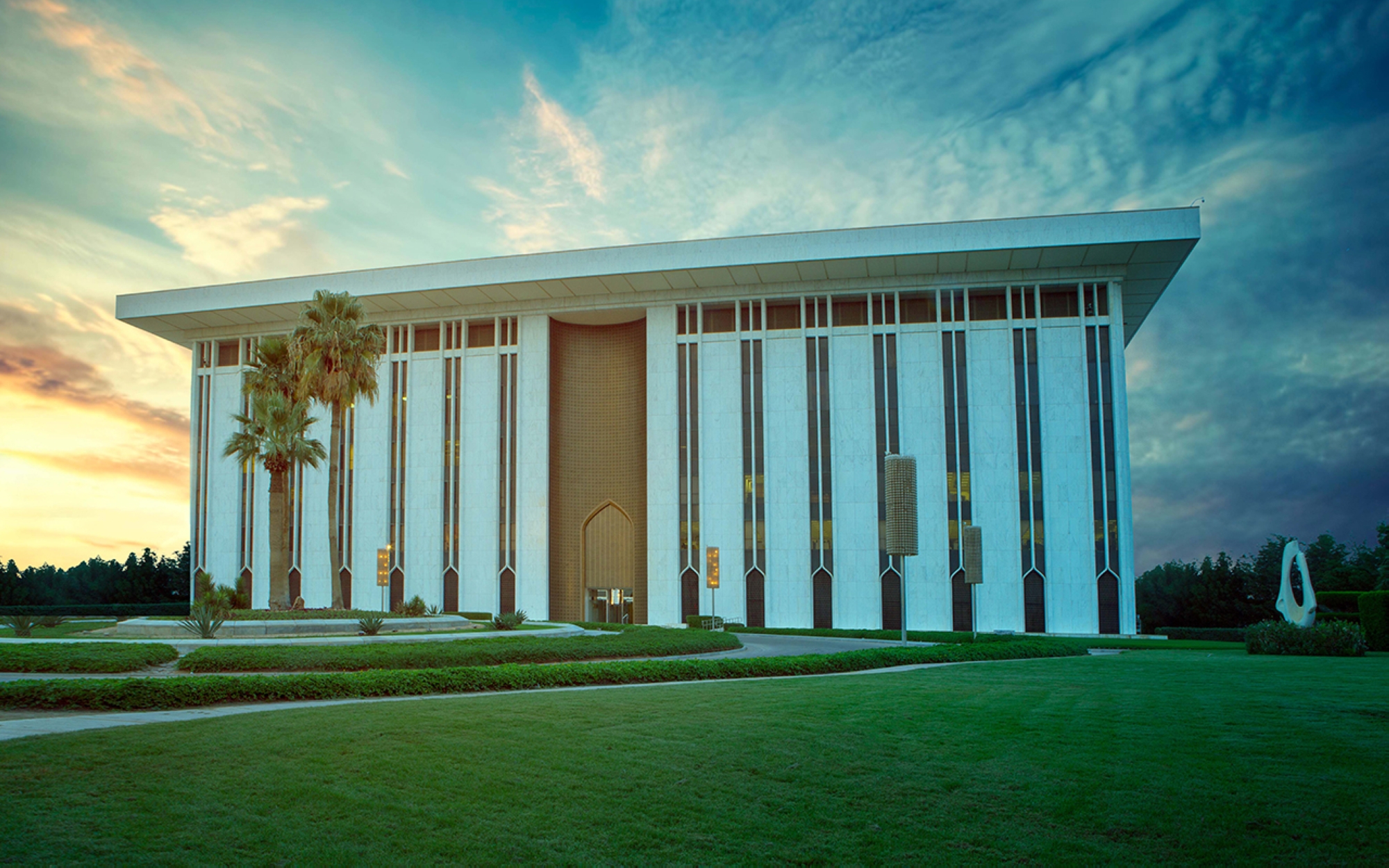
Saudi monetary laws
Saudi Arabia has witnessed the issuance of four monetary laws until the present time. The first was issued on January 9, 1928, in the official gazette "Umm Al-Qura", before the establishment of the Saudi Arabian Monetary Agency (now known as Saudi Central Bank). It was called the "Hejazi-Najdi Currency Law", under which the Arab Riyal was coined. The second law was issued in 1957, while the third was issued in 1957. The fourth law, issued on December 31, 1959, remains in effect to this day. This law authorized the issuance of an official banknote with the status of legal tender. It centralized the printing, minting, and issuance of Saudi currency under SAMA. Additionally, it introduced a decimal system, dividing the Riyal into twenty Qirsh instead of twenty-two.
Saudi Central Bank
The Saudi Central Bank was established during the reign of King Abdulaziz Bin Abdulrahman Al Saud on April 20, 1952. It represents the second oldest central bank in the Arab world. It was established to regulate the country's monetary conditions, and at that time, it was called the "Saudi Arabian Monetary Agency." On November 24, 2020, a Royal Order was issued to replace the name Saudi Arabian Monetary Agency with Saudi Central Bank, while retaining the same abbreviation (SAMA) by which it was known.
George A. Blowers, a US national, was the first governor of SAMA (currently the Saudi Central Bank). He had previously served as Deputy Director of the Economic Cooperation Administration, set up to administer the US Marshall Plan for economic rejuvenation in Europe. SAMA began its operations five months after its establishment on October 4, 1952, with Jeddah City as its headquarters.
During those years, SAMA opened branches throughout Saudi Arabia. The first branch was in Makkah Al-Mukarramah City on March 26, 1953, followed by the branch in Al-Madinah Al-Munawwarah on August 19, 1953. The Dammam branch opened on November 7, 1954, followed by Taif branch on January 31, 1955. Finally, a branch was opened in the capital, Riyadh, on February 8, 1955.
Upon its establishment, SAMA's initial responsibilities included stabilizing and bolstering the Saudi currency both domestically and abroad. Furthermore, it was tasked with advising the government on the minting and issuance of coins, as well as supervising the banking sector, which includes banks and currency exchange entities engaged in foreign currency trading. SAMA issued its first coins in 1957, with denominations of one, two, and four Qirsh.
Since its establishment, it has launched six issues of Saudi currency, both coins and banknotes. The first was during the reign of King Saud Bin Abdulaziz Al Saud on June 14, 1961. They included five denominations: SAR100, SAR50, SAR10, SAR5, and SAR 1.
The Saudi Central Bank currently undertakes several tasks and responsibilities, including issuing currency, providing banking services to the government, managing its foreign exchange reserves, managing monetary policy to maintain price stability, in addition to supporting the financial system and ensuring its soundness, monitoring commercial banks, finance companies, cooperative insurance companies, and credit information companies.
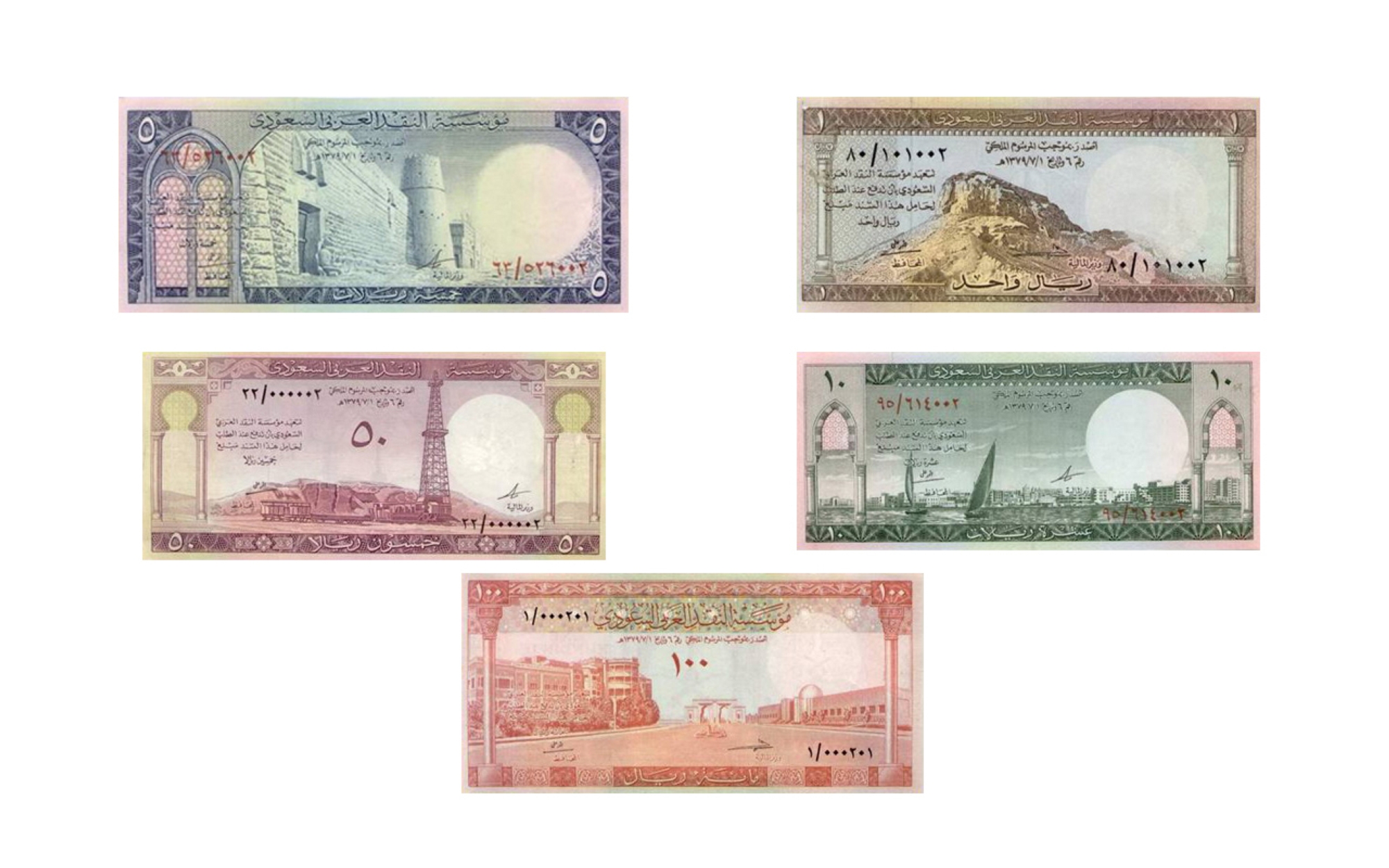
Saudi currency issuances
The first Saudi metal currency
With the increasing demand in the local market for a larger quantity of money, King Abdulaziz minted the first issuance of the Saudi currency. These included copper coins for the denominations of a quarter Qirsh and half Qirsh. The front featured the full name of King Abdulaziz written in Tughra style inscription along with the Hijri date of minting (1343 AH / 1925 AD). On the back side, the coins displayed the monetary value of the denomination and the place of minting (Umm Al-Qura).
Due to the increasing demand, in that same year, the king ordered the minting of more coins similar to the previous ones but with some differences in the inscription of the king's name. It was changed to read "Abdulaziz Bin Abdulrahman Al-Faisal" instead of "Abdulaziz Bin Abdulrahman Al-Faisal Al Saud," as it was in the initial batch. In early 1926, he also commanded the minting of more half Qirsh coins.
This time, the coins were minted with a different design. The inscriptions, including the place and date of minting, and the currency value, were distributed in an aesthetic manner on the back. The front bore the name of King Abdulaziz without any of his titles, "Abdulaziz Bin Abdulrahman Al-Faisal Al Saud," and at the bottom, the year (two) indicated the second year of King Abdulaziz's rule after the unification of Hejaz. This issue was considered one of the rarest coins minted in Makkah Al-Mukarramah, as it bore the name "Umm Al-Qura" which did not appear on the coins before this date.
The first saudi paper currency
Over the past decades, Saudi Arabia has issued six issuances of paper currency and introduced various forms of money. During the reign of King Saud Bin Abdulaziz Al Saud, the first official paper currency issue was issued in denominations of SAR100, SAR50, SAR10, SAR5, and SAR1, on June 15, 1961. Ten years after the issuance of the first paper currency, it was withdrawn from the markets on June 24, 1971.
The front of the currency bore the name "Saudi Arabian Monetary Agency" along with the date and number of the Royal Decree under which it was issued. At the bottom was the value of the note in Arabic, while to the right was the watermark and security thread. On the left was SAMA's pledge to pay the value of the note, accompanied by the serial number, the governor's signature, and the Minister of Finance's signature at the bottom. The reverse side featured Saudi Arabia's emblem with the King's name below it, the English name of SAMA, and the corresponding value in English on the right.
The SAR1 denomination was issued in maroon, with an image of Jabal Al-Nour in Makkah Al-Mukarramah at the center, while the SAR5 denomination was printed in blue and featured an image of Al-Masmak Palace in Riyadh City. The SAR10 note was green, featuring a depiction of Jeddah Port. The SAR50 note was maroon, showcasing an image of an oil refinery with two minarets on the sides of the reverse. Finally, the SAR100 note was mostly red, bearing an image of the gate of Al-Nasiriyah Palace in Riyadh.
Saudi currency calligrapher
Saudi calligrapher Abdulrazzaq Khoja was the first to inscribe Saudi currency, having written on both paper and metal currencies issued by the Saudi Arabian Monetary Agency (as it was known then) during the reigns of King Faisal Bin Abdulaziz Al Saud, King Khalid Bin Abdulaziz Al Saud, and King Fahd Bin Abdulaziz Al Saud.
Development of the Saudi currency from the first to the sixth issuance
The Saudi currency in its early days was initially tied to the appearance of foreign coins made of copper-nickel. The new coins at that time featured the name and title of King Abdulaziz (King of the Hejaz and Sultan of Najd), engraved in marginal writing on the denominations' faces. After the unification of the country, a Royal Decree was issued on September 22, 1932, to change the name of the nation from the Kingdom of Hejaz and Najd and its dependencies to the "Kingdom of Saudi Arabia" and to adopt the title "King of the Kingdom of Saudi Arabia." The first instance of this title appearing on Saudi coins was in 1935 on the Silver Riyal and its fractions of SAR0.25 and SAR0.5.
The Saudi paper currency in the first and second issuances did not feature the faces of the ruling kings, but they appeared in subsequent issuances (from the third to the sixth). The first two issuances instead used images of certain landmarks of Saudi Arabia, such as the Two Holy Mosques and Jabal Al-Nour in Makkah Al-Mukarramah, the Council of Ministers building, Al-Masmak Palace, the gate of Al-Nasiriyah Palace, and an oil refinery.
In the third issue, during the reign of King Khalid Bin Abdulaziz Al Saud, the first appearance of the kings' faces on the banknotes occurred, with the SAR100 featuring a portrait of King Abdulaziz Bin Abdulrahman Al Saud, and the rest of the denominations featuring a portrait of King Faisal Bin Abdulaziz Al Saud.
During the reign of King Fahd Bin Abdulaziz Al Saud, the fourth issuance of currency introduced the SAR500 denomination for the first time, reflecting the country's economic growth. The fifth issue, released under King Abdullah Bin Abdulaziz Al Saud, featured several security measures aimed at distinguishing authentic banknotes from counterfeits. The sixth issue under the Custodian of the Two Holy Mosques, King Salman Bin Abdulaziz Al Saud, introduced the first Saudi currency made of polymer, distinguishing it from the existing cotton-based currencies.
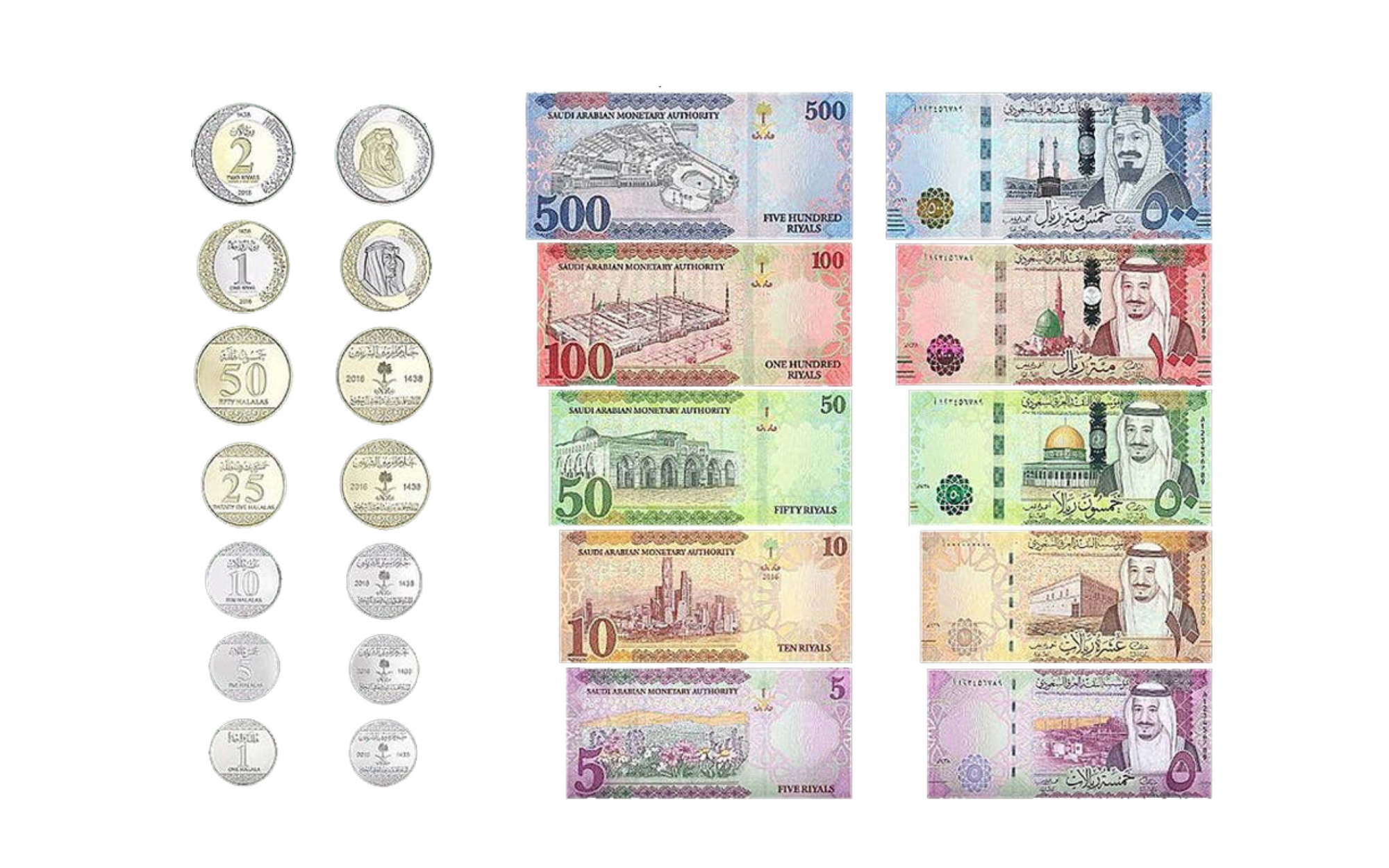
The Saudi currency during the reign of King Salman Bin Abdulaziz
The sixth issuance of the Saudi currency
During the reign of the Custodian of the Two Holy Mosques, King Salman Bin Abdulaziz Al Saud, the sixth issuance of the Saudi currency was launched under the slogan "Trust and Security." It included thirteen coin and banknote denominations designed according to global techniques and standards that consider technical and security specifications. The launch began on December 26, 2016, for several paper denominations: SAR500, SAR100, SAR50, SAR10, and SAR5. The coin denominations included: SAR2, SAR1, fifty halalas, twenty-five halalas, ten halalas, five halalas, and one halala.
On September 28, 2020, a SAR5 denomination made of polymer was introduced, with colors and designs similar to the cotton-based version, but with differences in manufacturing techniques and security features. On January 4, 2021, a SAR200 denomination was introduced to commemorate Saudi Vision 2030, and a SAR20 denomination was also issued.
Unlike the previous five currency issuances, which bore the signatures of both the Minister of Finance and the governor of the Saudi Arabian Monetary Agency, the sixth issue featured the signature of the Minister of Finance on all paper currencies, alongside the name of the governor. However, on the SAR5 polymer note, only the names of the governor and the Minister of Finance were included, without any signatures.
Paper currencies (banknotes)
The SAR500 banknote represents the highest value in the sixth issuance of Saudi banknotes. On the front, there is a portrait of the Founding King Abdulaziz Bin Abdulrahman Al Saud and Al-Kaaba, while the reverse side features a view of the Grand Mosque in Makkah Al-Mukarramah, with the banknote predominantly colored in blue. On the SAR200 denomination, there is a portrait of King Abdulaziz on the front, along with the three-dimensional logo of Saudi Vision 2030. On the reverse side, there is an image of Qasr Al-Hukm located in the capital, Riyadh. The banknote is predominantly gray in color.
The SAR100 banknote features a portrait of the Custodian of the Two Holy Mosques, King Salman Bin Abdulaziz Al Saud, and the Green Dome of the Prophet's Mosque, while the reverse depicts a view of the Prophet's Mosque in Al-Madinah Al-Munawwarah, with the banknote predominantly in red. The SAR50 banknote, on the other hand, is mostly in green, with a similar front design to the SAR100, showing King Salman's portrait alongside the Dome of the Rock Mosque, and on the reverse, an image of Al-Aqsa Mosque in Palestine.
The SAR10 banknote also features a portrait of King Salman on the front, along with a view of Al-Murabba Palace in Riyadh City. While the reverse shows an image of the King Abdullah Financial District (KAFD) in Riyadh, in a brown color. In the category of SAR5 banknotes, there is an image of King Salman alongside the view of the Shaybah field situated in Al-Rub' Al-Khali (Empty Quarter). In the background, there is a depiction of wildflowers. This banknote features a purple hue and corresponds with the polymer version of the same denomination in terms of color and size. Both versions share identical front and back images, with the polymer variant incorporating a transparent window derived from the Saudi Vision 2030 logo.
Coins
The sixth issuance of the Saudi currency included seven coin denominations: SAR2, SAR1, fifty halalas, twenty-five halalas, ten halalas, five halalas, and one halala. The SAR2 coin is the highest valued Saudi coin in this issuance, featuring a golden center and a silver frame. On the obverse side, it showcases a portrait of King Abdulaziz, with his full name 'King Abdulaziz Bin Abdulrahman Al Saud' inscribed on the right side, accompanied by a repeating state emblem set within a plant-based decorative frame on the left side.
The reverse side features a predominantly golden hue, with the numerical denomination positioned at the center, the written denomination above it, and the English denomination below. A silver frame encircles the design, adorned with the inscription 'Kingdom of Saudi Arabia' on the right side, while a plant-based decorative motif frames the left side, embellished with several repetitions of the state emblem. Above the coin, the date in the Hijri calendar (1438) is inscribed, while below it, the date in the Gregorian calendar (2016) is displayed. The SAR1 coin matches it in shape, front and back, with the front featuring a portrait of King Salman. The edges are framed in gold, and to the right of the portrait appears the inscription 'Custodian of the Two Holy Mosques, King Salman Bin Abdulaziz Al Saud'.
For the halala denominations, the fifty halalas coin features a singular color scheme predominating. Its face bears the national emblem at its center, adorned above with the title 'Custodian of the Two Holy Mosques' and a floral motif on the top. Beneath the emblem, the inscription 'King Salman Bin Abdulaziz Al Saud' is displayed. To the right, the Hijri date (1438) is inscribed, juxtaposed with the Gregorian date (2016) on the left. Floral decorative elements embellish both the top and bottom of the denomination. On the reverse side, the coin showcases the numeral (50) at its core, flanked by the Arabic inscription 'fifty halalas' above and its English counterpart below. Adorned with floral motifs at the upper and lower edges, mirroring the design on the obverse. The twenty-five halalas coin bears analogous embellishments, save for the absence of the numerical denomination.
The ten-halal denomination coin is predominantly made of silver, featuring Saudi Arabia's emblem at its center. At the top is the title 'Custodian of the Two Holy Mosques'. The obverse side of the coin showcases a floral decoration surrounding the emblem, with the name of King Salman Bin Abdulaziz 'King Salman Bin Abdulaziz Al Saud' engraved at the bottom. Additionally, the Hijri year number (1438) is inscribed on the right side, and the Gregorian year (2016) on the left side. Floral decorative inscriptions adorn both the top and bottom edges of the coin. The five halalas and one halala coins follow a similar design.
Security features
The sixth issuance of the Saudi currency, coined during the reign of King Salman, includes security features to distinguish genuine banknotes from counterfeit ones. The Saudi Central Bank displays these features for each denomination. The SAR500, SAR100, and SAR50 banknotes share six security features: a shiny silver strip, a three-dimensional security strip, special ink layers, raised printing, a feature for the visually impaired, and fluorescent patterns visible under ultraviolet light. The SAR200 banknote has two additional features: an iridescent ink strip in a decorative design and microprinting.
The SAR5 and SAR10 banknotes each incorporate five security features, including raised printing, a tactile feature for the visually impaired, phosphor patterns, microprinting, and a security thread. The SAR5 polymer banknote has three additional features: a transparent window derived from the Saudi Vision 2030 logo, optically variable ink, and iridescent ink.
The Saudi currency in local culture
Commemorative currencies
The Saudi Arabian Monetary Agency (now the Saudi Central Bank) has released several commemorative banknote editions for various occasions. Among these are the SAR200 and SAR20 banknotes issued in January 1999 to commemorate the hundredth anniversary of the establishment of Saudi Arabia. The SAR200 banknote showcases a portrait of King Abdulaziz at its center, accompanied by an image of Al-Masmak Palace in Riyadh City on the right side, and the name of the Saudi Arabian Monetary Agency encircling the repeated state logo. At the bottom, the signatures of the Minister of Finance and the governor are featured. The back features a picture of Al-Masmak Palace and the text "On the Occasion of the Establishment of Saudi Arabia."
The SAR20 banknote features a portrait of King Abdulaziz in the center. To the right of the portrait is an image of Quba Mosque in Al-Madinah Al-Munawwarah, with the name SAMA above it. Surrounding the metal layer containing SAMA’s logo are repeated depictions of Saudi Arabia's emblem. Below is the signature of the Minister of Finance and the governor. On the reverse side of the note, there is a depiction of Jabal Al-Nour in Makkah Al-Mukarramah.
Another SAR20 banknote was issued to commemorate Saudi Arabia's presidency of the Group of Twenty (G20). It features a portrait of the Custodian of the Two Holy Mosques, King Salman Bin Abdulaziz Al Saud, as well as the three-dimensional printed logo of Saudi Arabia's G20 presidency. On the reverse side, there is a world map depicting the G20 countries in a distinct color, highlighting Saudi Arabia's geographical location with a ray symbolizing the convergence of these nations on its soil.
Saudi currency application
The Saudi Central Bank launched the 'Saudi Currency' application in 2020, coinciding with the ninetieth National Day of Saudi Arabia, to raise awareness about the banknotes of the sixth issuance of the Saudi currency during the reign of the Custodian of the Two Holy Mosques, King Salman Bin Abdulaziz Al Saud. The application helps users identify security features interactively, ensuring clear recognition of these features. Additionally, it offers guidance and information to users regarding counterfeit currency, the penalties associated with its possession, controls on reproducing currency, and the penalties for defacing it.
The application enables users to recognize both the front and back of the banknote, discern the technical features of the sixth issuance, and detect security features through various means. These features comprise the shiny silver strip, the three-dimensional security strip, and the ink layers, thereby facilitating the identification and authentication of genuine currency.
Related quizzes
Related articles


